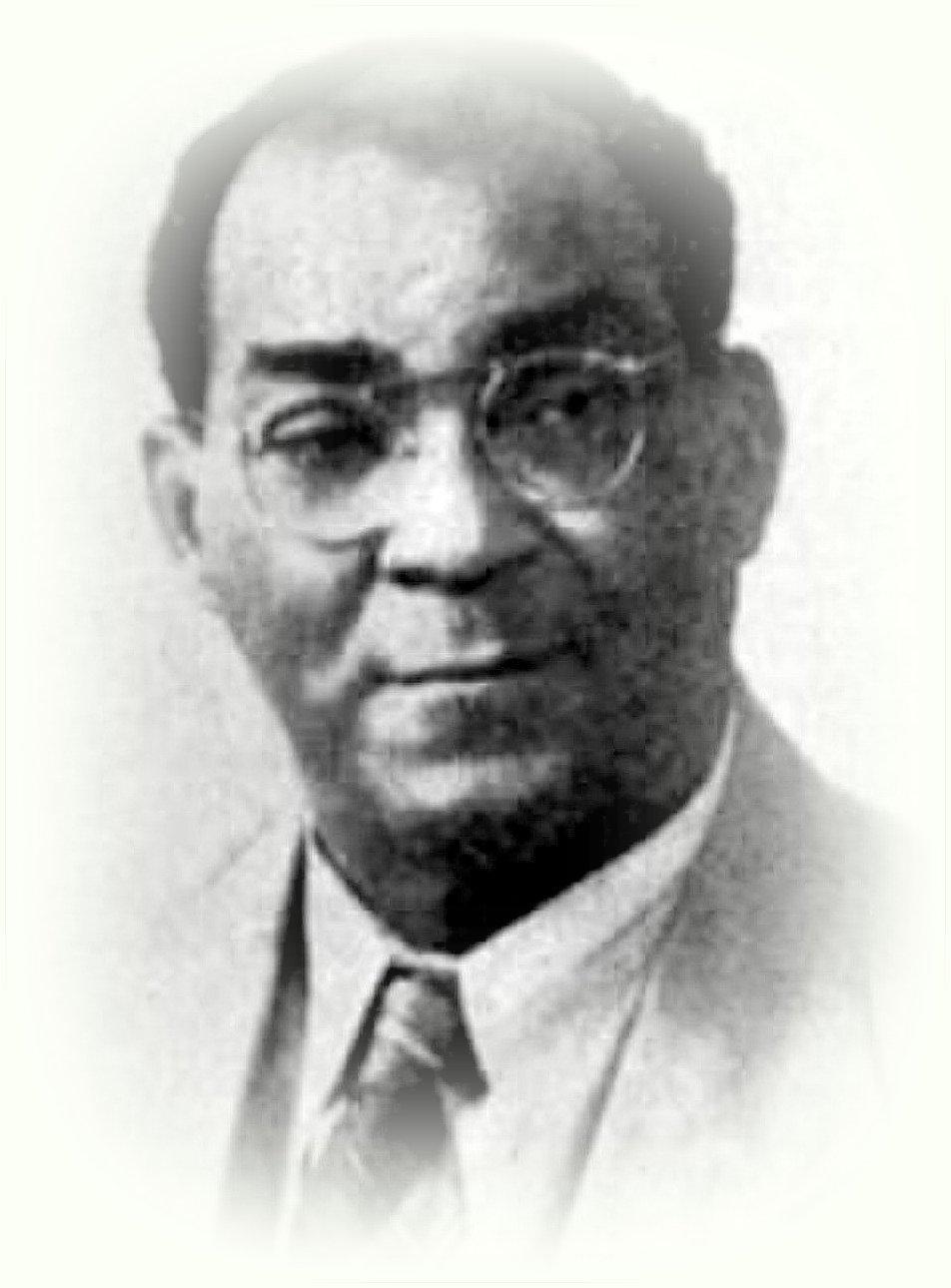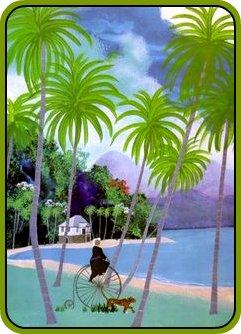I am pleading for Fern Gully, in St. Ann. Fern Gully 20 years ago was picturesque and beautiful. Today it is denuded and destroyed. I understand only £100 was placed for the upkeep of Fern Gully. Today that is gone. The ferns have been disappearing.
Dr O E Anderson, in the Legislative Council.
ask on behalf of the Parish which demands an immediate reply?
Board was responsible, but that owing to the outbreak of War no funds are available as there are no tourists!

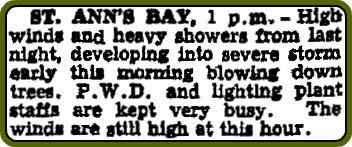
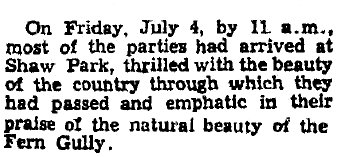

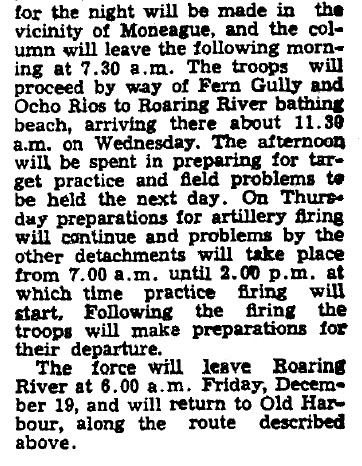

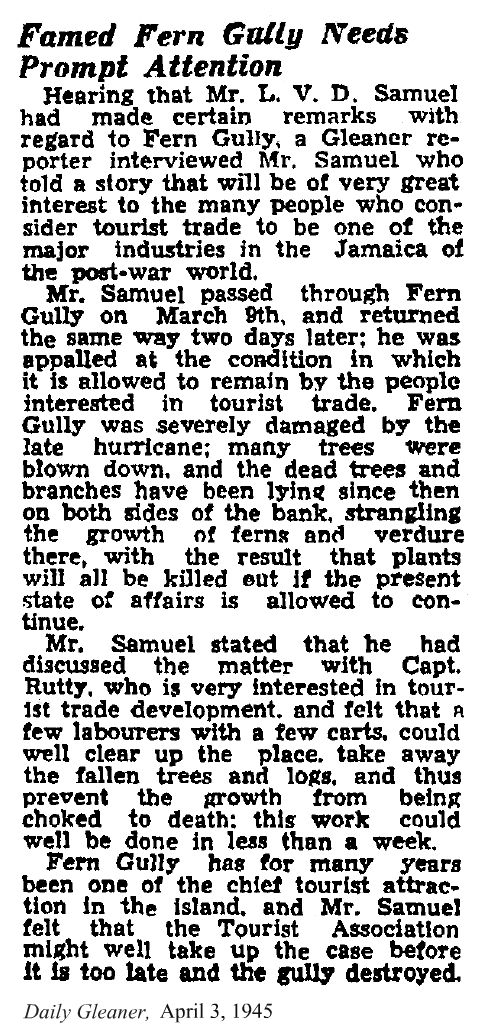
Daily Gleaner, September 12,
1946
Lorry-Car Collision
OCHO RIOS, September 11: (By telegraph from our, correspondent) —
Ocho Rios is fast becoming famous (or infamous) for the number of accidents occurring
at
or near the point where the [recent]
collision occurred which is on the Fern
Gully
road, and it has been argued
repeatedly that improvement is long overdue
on this stretch
of roadway.
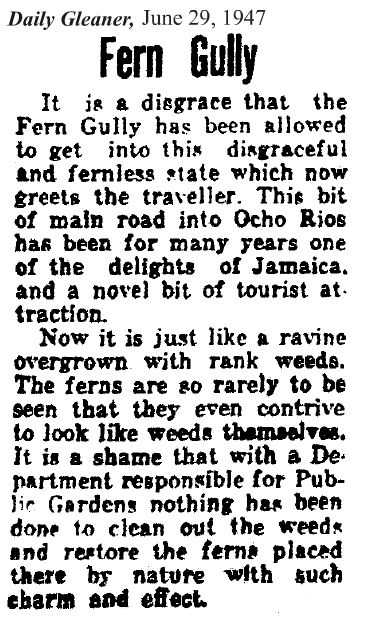

It was at this time that Dr George Proctor began his life-long study of Jamaican ferns, one of the latest in an honoured tradition of botanists who have devoted themselves to the study of Jamaica's remarkable and, in numerous instances, unique flora.
Daily Gleaner, June 27, 1950
A
five-hundred-dollar research grant has been made
by the American Philosophical Society to Mr
C.
Bernard Lewis, Director and Curator of
the Institute of Jamaica, for completion of field work on a
project which he is sponsoring in the study of the fern flora of Jamaica.
The
grant will allow for the continued study
of local fern species, which had long
been the study of the
late famed Dr. William Maxon of the Smithsonian Institution.
For
its size, Jamaica probably possesses more
species of ferns than any other country
in the world.
Over
500 are known. Many forms are widespread,
but the richest areas for ferns are the
wet slopes
and
gaps of the Blue Mountains, the Cockpit
Country, and the ever-rainy John Crow
mountains of
Portland.
With
the death of Dr. Maxon, it was found
that very little of his manuscript had
been written. Mr.
George K. Proctor, recently associated with the
Academy of Natural Sciences in Philadelphia,
and
formerly a lecturer in botany at
Temple University decided to take up the
project left unfinished
by Dr. Maxon.
Mr.
Proctor has just completed six munths
of field study of the subject. To make
this possible, the
Board of Governors
of the Institute of Jamaica assisted him
with a grant-in-aid to cover some of his
field expenses.
He
left the island mid-month to take up a
summer camp position in New Hampshire which
he has held
for a number of years.
He returns to the island in September
to continue the programme of field study
which this grant from the American Society will complete.
While
in the United States Mr. Proctor will
visit the Smithsonian Institution and the
Philadelphia
Academy for consultation and advice
with colleagues who are interested
in the project.
Before
returning to Jamaica, he will also
consult the herbarium of the New York
Botanical Gardens and other
leading students of ferns.
It is expected that as a result of this work, the volume on ferns for the "Flora of Jamaica", a series
published by the British Museum (Natural History) may be completed.
Heavy Rainfall
OCHO RIOS, St. Ann. February 3
(From Our Correspondent) — One of the heaviest showers of rain in the past ten years fell here this evening. The rain fell steadily for two hours, resulting in the newly asphalted Fern Gully-Ocho Rios road becoming inundated. Traffic was greatly
impeded.

HEAVY DAMAGE TO ROADS
By Cloudburst In St. Ann
OCHO RIOS, St. Ann, February 5.
(From our correspondent)
THE cloudburst on Saturday last has left the Public Works Department and Parochial Board with hundreds of pounds damage on their hands.
Since yesterday, the Public Works Department emergency squad has been at work to restore traffic to normal on the Fern Gully road.
Numbers 3 and 10 parochial roads are blocked. It will be some time before they are cleared.
Telegraphic and telephonic communications in some sections of the parish were disrupted.

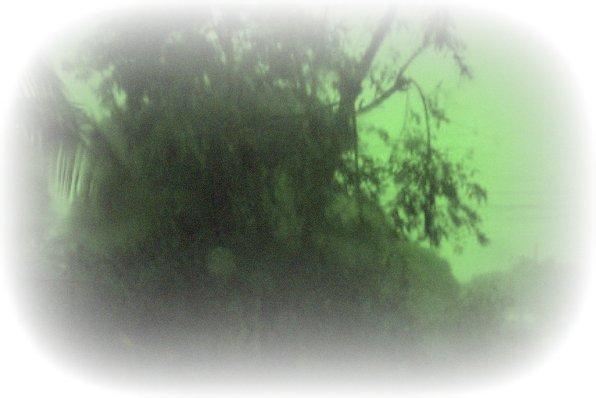
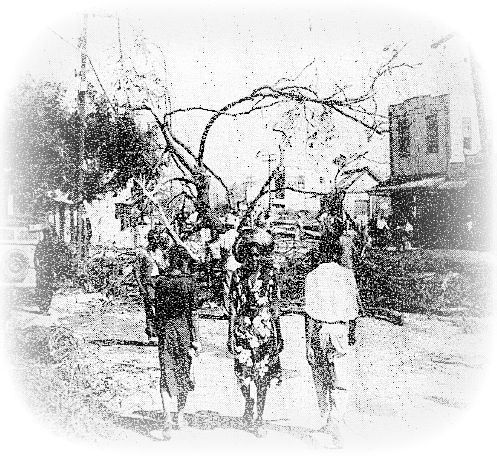

Inland crops are flattened and flooded, trees lie where they fell after being whipped off the ground by the black-funneled twister.
There was stoic calm in the face of death and even among those who were injured. There was courage in those who went eagerly to the help of their neighbours There was spontaneous generosity in the way in which
badly needed shelter, food and warmth were shared with neighbours between whom there had never been any real decree of friendship.
The days which have since passed have also revealed other qualities, resourcefulness and a capacity for
organisation. These qualities have manifest themselves,
not only at the highest level (where relief measures on a major scale are being put into effect) but in the smallest yards and homes. The little men and women have grouped themselves to do their best to help each other restore their homes and clear the debris with which their yards have been littered.
. . . .
I am told by competent observers that such has always been the case when disaster has overtaken any section of the Jamaican community.
. . . .
Never have I been so impressed with the nobleness of human beings as during Friday night and Saturday
morning. On Tuesday it seemed as if the Corporate Area was teeming with vigorous new life. The streets were rapidly being made shipshape.
People seemed to walk abroad with new zest and sense of determination. They were proudly aware of the fact that they had been tested in the crucible of fear and pain and had not been found wanting. The dross had been removed: the pure metal could now shine the brighter.
Nor must we forget the humour, robust, and often verging on the coarse, with which people helped to laugh away their cares.
lasting damage to the delicate ecology of
the district, so that many of the ferns were unable to
re-spore themselves
with success', and Aimee Webster deLisser wrote of its 'denudement' in 1951, but at the time there was virtually no reference to damage to Fern Gully. In fact within months it was firmly back on the tourist circuit.
Daily Gleaner, March 22, 1952
Although
they[Mr. and Mrs. Herbert Fleishhacker] have travelled extensively, they regard
Jamaica as "one of the treasure grounds of the world." They were particularly impressed with the view from Shaw Park, and with Fern Gully. They also consider Kingston 'a lovely city'.
Daily Gleaner, March 24, 1952
They
[Mr. and Mrs. Charles Emery, Mr.
David Grant and Mr.William Salisbury] declared that
they had never before seen such beautiful tropical foliage, and regard the Fern Gully as “divine.”
never visited the island, [nor Fern Gully,] whatever Jonathan Routh may have written!
Jonathan Routh died on June 4th, this year; he was 80.

Plans
for Royal tour: 'The scenery changes
radically as the road swings from the
bauxite
port of Ocho Rios, through the
famous Fern
Gully and on to the
limestone uplands of the
"garden parish” of St, Ann.'
On November 25 'Fern Gully was clothed in verdant splendour as the Royal party passed through.'
Mrs. Charles Whitford [actually she was the mother, by her first marriage, of 'Susan Lewis' who is noted at the bottom of this page], who left Jamaica for the USA in 1905, and returned for the first time in 1957, remembered Fern Gully as 'filled with maiden hair fern' and Ocho Rios 'as a little fishing village that no one heard much of'.
'You should be proud of your country. This is the most beautiful place I have ever seen and I have seen a lot. Your Fern Gully beggars description and the scenes I have enjoyed during my drives through the countryside are so delightful.'
'The Silver Seas station waggon transported them to the top of Fern Gully with their bicycles then they and the two eldest children cycled down the winding road.
"That's the real way to see the beanties of Fern Gully", said Mr. Mendell "You can look at the ferns rather than watching every curve every instant as you do in a car." Daily Gleaner, August 9, 1955
'Descending Mt. Diablo, the road narrows to just barely two-car width and enters Fern Gully where bamboo trees and giant ferns meet overhead turning bright daylight to dusk and where sunlight never shines.
"As you reach Ocho Rios, you'll look back at the mountains, the thick bottle-green jungle growth and the twisting, tortured roadway and wonder how you did it. But you did . . . and safely too . . .'

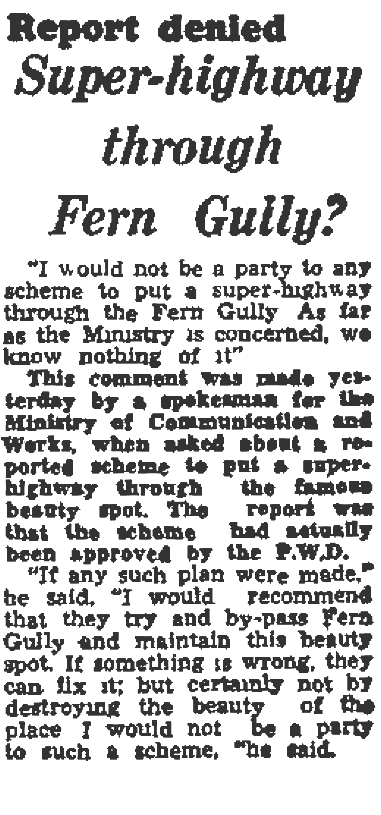
Garden of Ferns
THE
EDITOR, Sir:- A recent news article in
your paper mentioned the intention of the
Hope Garden authorities to plant clumps of
trees on the slight rise of land
between the
lake and the foot of the hills behind the Gardens.
Leading
up into the hills from this slight
escarpment are two or three wooded valleys
and I have often thought that with the
necessary shade and a good water supply,
these
valleys could be made into beautiful
ferneries, comparing more than favourably with
Fern Gully in its present condition. I
have seen within seven miles of King
Street a
beautiful little glade of ferns that to me was just as lovely as Fern Gully.
Some
years ago in your columns I read of
a naturalist visiting Jamaica to do research
on ferns who said that Jamaica had more
different varieties of ferns than anywhere
else
in the world and I think it
would be a fitting memorial to the late
Mr. Downes and his
wife's work for us,
which we take advantage of, whenever we
visit the beautiful Hope
Gardens if the
authorities would consider starting a garden
of ferns in one of these
valleys with funds provided by public subscription.
E .T. CLERK.
18 South Avenue,
Half Way Tree,
June 24, 1958

Susan Lewis
One of my favourite fragrances is Fern Gully. Driving up through that narrow pass from Ocho Rios to Colgate, I open wide all the windows of my car to let in the moist cool humus smelling air, hoping it will remain in the car to comfort me as I descend Mount Diablo into the warmer section of the island.
Though it does not stay to the car, the memory of that cool fragrant air carries me until I can get by the sea in Kingston or best of all out at Port Royal, one of the loveliest places in Jamaica. Returning from Kingston to the North Coast, one of the signals of arrival on my own territory is the cool air that blows in the car after the climb up Diablo's rough side. Then I know it is only a short time until I get a glimpse of my beloved sea on the North.
Down, down through Fern Gully again usually at dusk and the marvellous ancient humus fragrance fills the car again and into the maddening crowd of Ocho Rios at market time; then the slightly fishy but pleasant smell of Ocho Rios Harbour past the dusty docks of bauxite and then the mile upon mile of visual and olfactory feast - the sea.

- born Susan B Anthony,
- great-niece of the feminist activist of that name,
- whose mother was Charlotte Sutherland, daughter of A N Sutherland, the original developer of the Moneague Hotel,
- was a remarkable woman in her own right.
She lived in Jamaica from 1954 to 1960, and
was a correspondent for the Gleaner most
of that time.
Read more >>>


